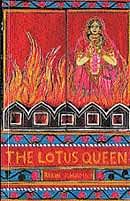
The Lotus Queen
Rikin Khamar
Rupa
2011, pp 157
195
Legends have an enduring quality about them that the passage of time cannot seem to dim. In fact, time seems to suffuse them with a warmer and more alluring glow. Since they lend themselves so beautifully to individual interpretations, they can easily be woven into unique works of art by an expert hand.
In Lotus Queen, Rikin Khamar does just that. Borrowing from historical events, places and persons of the time, he spins his version of the fate that befell the legendary Queen Padmini of Chittor.
Despite numerous fictional renderings about Queen Padmini — in the form of songs, plays, stories, poems, and movies — there is very little historical evidence to support her existence. Recorded history, however, does talk about Rawal Rattan Singh, her husband, who ruled over Mewar for a short period, from 1302 to 1303 AD.
The fort of Chittor, that stands in partial ruin to this day, was under siege for eight long months in 1303 AD, during Rattan Singh’s reign. The battle ended with the drastically outnumbered Rajputs riding out in a death charge against Alauddin Khilji’s forces, and the mass immolation of the women of the royal family. Years later, a warrior of the Sesodia clan, Hammir Singh, is said to have recaptured the fort of Chittor.
Khamar takes these recorded facts, churns them with incidents from his vivid imagination, and gives us in simple, yet evocative prose, a crisp book worth reading. Told from the perspective of six different characters, the story begins with young Padmini reminiscing about her wedding to Rattan Singh.
Then, she had, in an act of adventurous abandon, disguised herself to ride into the countryside to catch a glimpse of the man she was to marry. Soon, we are given an account of her bewitching beauty. It was popularly believed that she was given a boon that would make anyone who looked directly into her eyes fall hopelessly in love with her. This very boon proves to be her undoing, leading to the destruction of the powerful Kingdom of Mewar and the fort of Chittor.
The seeds of the final tragedy are sown even before Padmini can settle down in her new husband’s home. The Sultan of Delhi, Alauddin Khilji, having heard of her famed beauty, asks to have a glimpse of her. The request is an outrage that no self-respecting Rajput can tolerate. Still, for the sake of political expediency, the Sultan is allowed to enter Chittor, but shown another woman in a mirror.
No fool, the Sultan sees through the ruse. That very night, Padmini is compelled to reveal her unveiled face to Alauddin Khilji, who immediately wants to possess her. He kidnaps Rattan Singh and asks for Padmini as ransom. However, fiery Padmini executes a plan that rescues the king without compromising her honour.
The Sultan, in no mood to give up, gets reinforcement from Delhi and lays siege to the fort of Chittor. A long-drawn battle follows. The Rajputs know, with their numbers, there is no way they can win, but fight on until the last man. The women of the palace, led by Padmini, rather than submit to their new masters, commit the ultimate act of self sacrifice by throwing themselves into a pyre.
It goes to his credit that Khamar’s writing has been able to effortlessly capture the spirit of the valiant Rajputs who preferred death to dishonour.